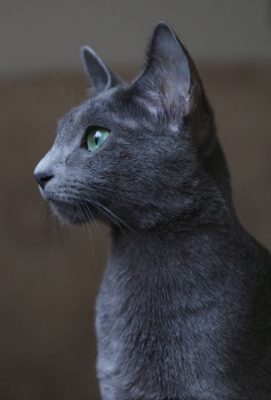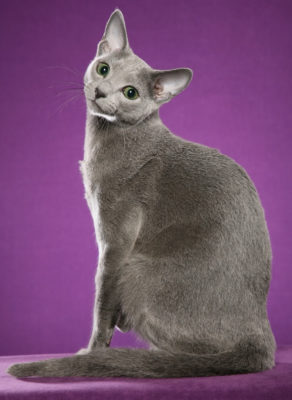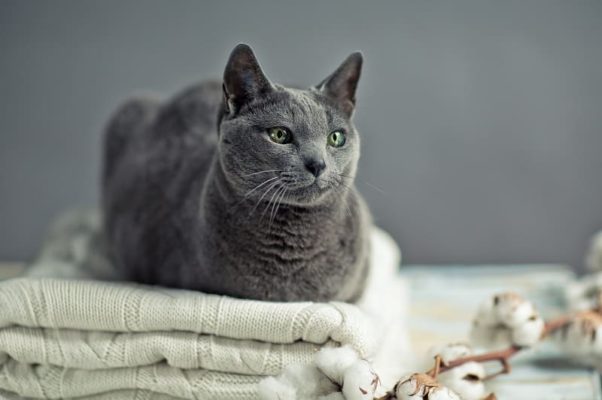Russian Blue
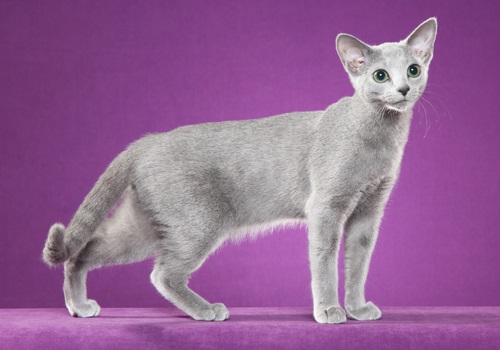
The Russian Blue cat is an affectionate and loyal breed. You should not be surprised that it will follow its owner or mistress everywhere. If the cat lives with the family, it tends to become attached not to one family member but to everyone who lives in the house. She likes to give attention to both adults and children and demands the same in return.
Table of Contents
Breed Information
| Origin | Russia |
| Size | 23-25 cm |
| Weight | Males 3.5-6 kg Females 2.5-5 kg |
| Fur Type | Short-haired |
| Color | All shades of blue (from light to dark) |
| Lifestyle | Indoors |
| Lifespan | 15-20 years |
| FIFe Classification | Category III: “Short-haired and Somali” Breed designation – RUS |
| WCF Classification | Group 3: “Short-haired” Breed designation – RUS |
| TICA Classification | RB |
| Group | Hypoallergenic cats, short-haired cats, rare cats, apartment cats (docile cats) |
| Price | $600-800 |
Breed Photos
Origin History
The Russian Blue cat is a fairly rare breed, about the origin of which little is known. It is believed that the Russian Blue cat comes from northern Russia, particularly from the Arkhangelsk Islands. The thick coat of these cats supports the theory that they evolved in a cold climate. It is rumored that in 1860, Russian Blue cats were brought to Britain by British sailors from the White Sea port city of Arkhangelsk.
The Russian Blue cat first appeared in public in 1875 during an exhibition at London’s Crystal Palace. At first, the breed was exhibited with other blue cats, but in 1912 separate standards for the Russian Blue were adopted. Then the breed was actively developed until the Second World War, and after that, it became almost extinct, like many other breeds. In 1947, breeders tried to revive this breed and then promote it in the United States. Today, the Russian Blue takes part in the championships of all the feline associations in North America.
Appearance
The Russian Blue is a small cat with a muscular and slightly elongated build. This cat has a wedge-shaped head. The upper part of the skull is long and flat in profile, descending smoothly just above the eyes and continuing at a slight downward angle. The neck is long and thin, but the presence of thick fur visually makes it short.
This cat has large, wide ears pointed at the tips. On the outside, the thin ears are covered with fur, and on the inside, you can see the skin of soft pink color. The limbs of the Russian Blue are long, and the legs are muscular with pink pads. The eyes are almond-shaped and only green. Other eye colors are considered a marriage.
A beautiful silky coat is the calling card of the Russian Blue cat. Its fur is short, of equal length throughout the body. The color of the coat is evidenced by the name of the breed itself – from dark to light shades of blue.
Character
The Russian Blue cat is an affectionate and loyal breed. You should not be surprised that it will follow its owner or mistress everywhere. If the cat lives with the family, it tends to become attached not to one family member but to everyone who lives in the house. She likes to give attention to both adults and children and demands the same in return.
Russian Blue cats are sociable creatures, but at the same time, they can be quiet. These pets sometimes like to spend time alone; they can hide in a cozy corner where no one will see them. They avoid strangers, and when guests come to the house, they nobly English leave the noisy room and wait for everyone to leave.
Representatives of this breed are usually polite, calm, and well-behaved towards other cats. They are observant and persistent, always making sure that their needs are met.
Care
In caring for Russian Blue cats, it is very important to follow the rules of hygiene. A silky blue coat requires minimal care – a weekly combing with a brush with medium teeth will be enough. It will help keep the coat healthy. It is very important to brush your cat’s teeth, so you need to make sure she has her toothbrush and special cat toothpaste. Also, you need to make sure that the ears and eyes are clean and that the claws are trimmed. Russian Blue cats are very clean and squeamish; they will not go to a dirty litter box or eat from a dirty bowl. Therefore, you need to keep them clean, change the litter box regularly and wash the bowl after each meal.
Education
Russian Blue cats are brilliant animals. They need physical activity and mental stimulation, so it is important to provide them with enough toys. Sometimes the hunting instinct wakes up in these cats, and a fishing rod and fish is an excellent toy for this breed that will motivate the kitten to move and think. Russian Blue cats like routines and do not like changes. So if they are going to be, it is better to prepare the cat for them gradually. Teaching the litter box, prohibiting climbing on the table or scratching the furniture, and bathing will be given to Russian Blue cats without any problems.
Common Diseases
The Russian Blue is characterized by good health and excellent immunity because it is a naturally occurring breed. It is also not prone to genetic diseases. With proper care, the life expectancy of the cat can be 20 years.
Retinal atrophy and polycystic kidney disease can be diagnosed in cats of this breed, but such cases are infrequent. It is necessary to comply with the vaccination schedule, which will help avoid diseases such as panleukopenia, calicivirus, rabies, rhinotracheitis. Regular ear hygiene will protect against ear inflammation.
Nutrition
To avoid overeating, you should feed the cat up to three times a day in small portions, and no case should you leave food in the cat’s bowl for the whole day. The cat will eat leftover food in the first few hours, and by evening it will be asking for more. Overeating the cat can lead to obesity, which in turn negatively affects its health.
It is recommended that the Russian Blue is fed high-quality premium food, but this does not exclude the possibility of feeding the natural cat food. These pets can be offered dietary meats – boiled beef, turkey, chicken, and by-products from natural food. Also, the diet can include chicken yolk and processed sea fish, low-fat dairy products, vegetables, cereals. The diet’s basis should consist of meat; the other products should be alternated to make the food varied. Smoked, salted, and fried delicacies are taboo for the Russian Blue.
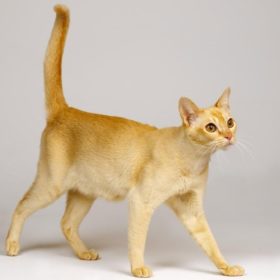 Ceylon
Ceylon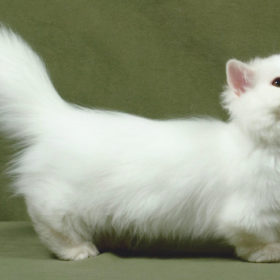 Minuet (Napoleon)
Minuet (Napoleon)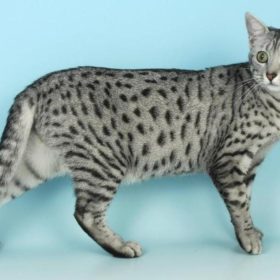 Egyptian Mau
Egyptian Mau Thai
Thai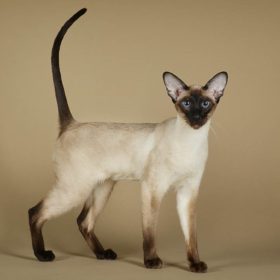 Siamese
Siamese Karelian Bobtail Shorthair
Karelian Bobtail Shorthair